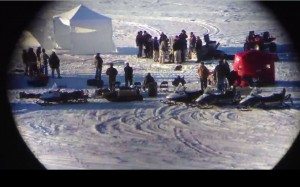 Police invariably keep journalists so far back from crime scenes that it’s almost impossible to see what’s going on with the naked eye. That’s the situation KTUU’s Jason Lamb faced earlier this month, as police prepared to search a frozen lake for the body of a missing woman.
Police invariably keep journalists so far back from crime scenes that it’s almost impossible to see what’s going on with the naked eye. That’s the situation KTUU’s Jason Lamb faced earlier this month, as police prepared to search a frozen lake for the body of a missing woman.
Photographer Mike Nederbrock had a decent shot using a doubler but he wasn’t in a position to go live. Lamb wanted to get some video online in a hurry but all he had was an iPhone. Then Nederbrock mentioned the pair of binoculars he keeps in his car. Putting the binoculars in front of the phone’s camera lens gave Lamb a useable shot (click link for video).
We were waiting outside for about an hour before those divers went in. I knew I wanted to get the shot of the diver going in, so I waited until it looked like they were ready to go, then hit the record button. After it was finished, I immediately posted the video to Facebook and Twitter.
The station never aired the iPhone video because Lamb and Nederbrock were able to get their camera footage back in time for the next newscast.
Chief photographer Kevin Mahan of KSEE in Fresno says he recently faced a similar situation and found a different but equally effective solution.
I have a Panasonic AG-HPX370 with the LCD side monitor. I was out on breaking news, no live truck, zoomed in with my P2 shot some video and then on playback shot :25 seconds with my iphone, e-mailed it back, and we had fresh video for our 4pm.
If there’s a lesson here, it’s that quick thinking can break down what appear to be insurmountable barriers to getting the job done. Your smartphone can do even more than you might think. Oh, and one more thing: it’s always a good idea to have binoculars in your go-bag.








